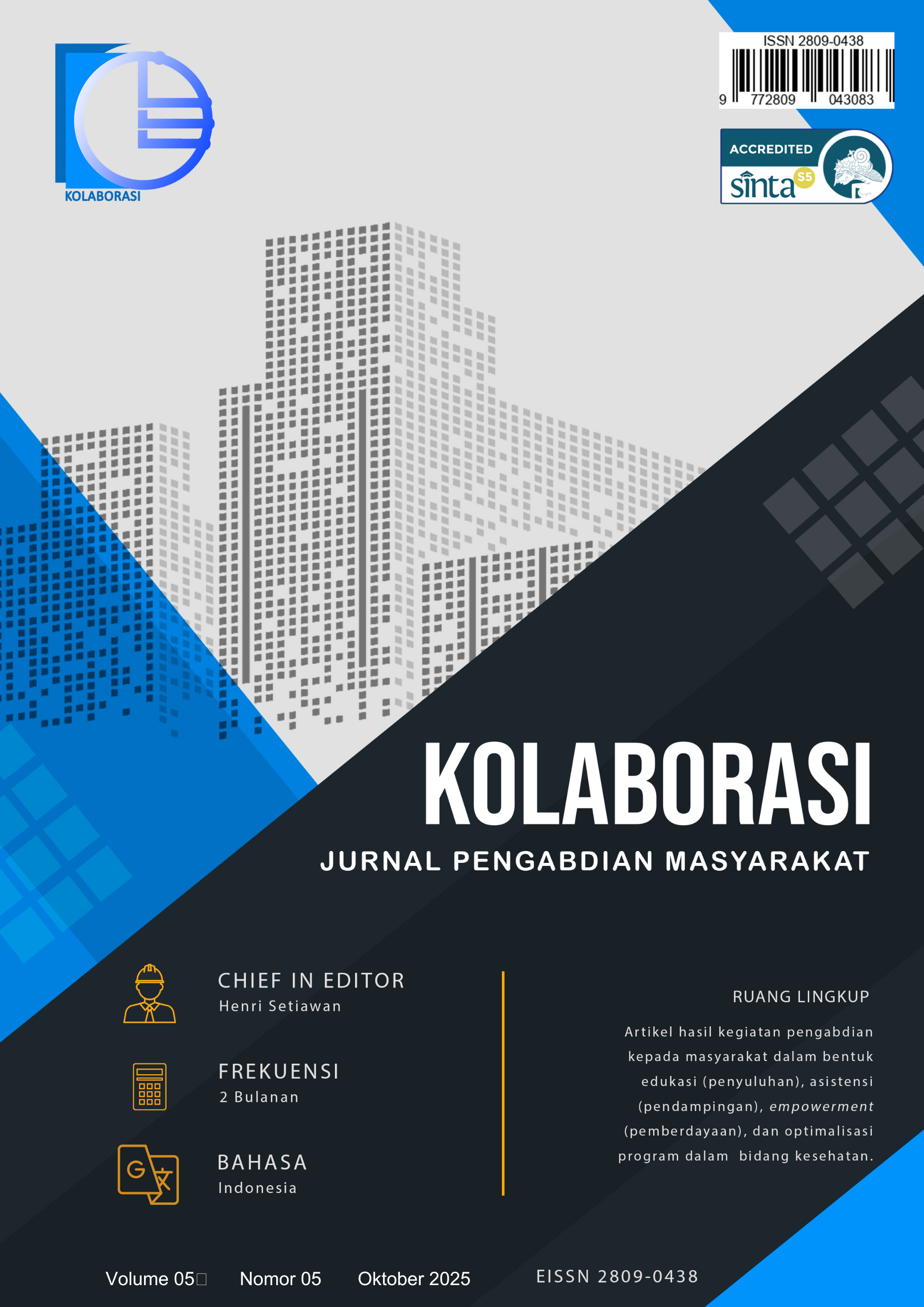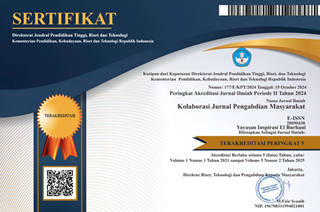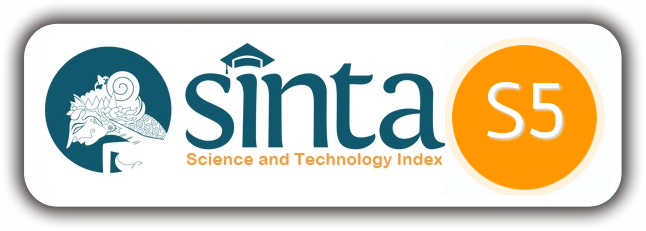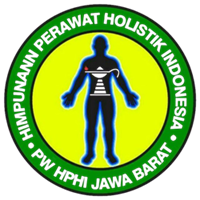Penerapan Terapi Butterfly Hug untuk Mengelola Kecemasan Ujian pada Remaja di SMP Negeri 9 Purwokerto
DOI:
https://doi.org/10.56359/kolaborasi.v5i5.635Kata Kunci:
Anxiety, butterfly hug, teenagerAbstrak
Introduction: Adolescence is marked by physical and emotional changes that can increase the risk of anxiety disorders. The butterfly hug is a non-pharmacological relaxation technique to help control anxiety.
Objective: This study aims to evaluate the effectiveness of butterfly hug therapy in reducing anxiety levels among 9th-grade students at SMP N 9 Purwokerto.
Method: This activity was conducted at SMP N 9 Purwokerto on March 20, April 9, and April 17, 2025, targeting adolescents aged 12–18 years selected purposively based on mild to moderate anxiety levels measured by the Zung Self-Rating Anxiety Scale (ZSAS) and parental consent. The intervention applied the Butterfly Hug technique, consisting of crossing the arms on the chest and alternately tapping the shoulders combined with mindful breathing. The implementation included preparation (coordination with school and parents, preparation of educational materials), education (providing information on anxiety and demonstration of the Butterfly Hug), intervention sessions (guided individual and group practice), and evaluation (pre- and post-intervention ZSAS, observation, and feedback). Data were analyzed descriptively to assess changes in anxiety levels. Ethical principles were maintained, including informed consent, confidentiality, and voluntary participation.
Result: The results show that the majority of respondents were 15 years old (51.4%) and male (51.4%). After the intervention, 31 students (88.6%) experienced a decrease in anxiety to the point of no anxiety, while 4 students (11.4%) decreased from moderate anxiety to mild anxiety.
Conclusion: Butterfly hug therapy effectively reduces students' anxiety levels when facing exams.
Unduhan
Referensi
Afradi, A., Tarahomi Ardakani, H., Mousaee, S., Malekpour, O., & Ramezanzadeh, A. (2025). The neurochemical basis of emotions: Bridging psychology and chemistry. International Journal of New Chemistry, 12(5), 1013–1028.
Anderson, T. L., Valiauga, R., Tallo, C., Hong, C. B., Manoranjithan, S., Domingo, C., & Goldhaber, K. (2025). Contributing Factors To The Rise In Adolescent Anxiety And Associated Mental Health Disorders: A Narrative Review Of Current Literature. Journal Of Child And Adolescent Psychiatric Nursing, 38(1), E70009.
Anissa, L. M., Suryani, S., & Mirwanti, R. (2018). Tingkat kecemasan mahasiswa keperawatan dalam menghadapi ujian berbasis computer based test. Medisains, 16(2), 67–75.
Astuti, N. A. P. (2024). Butterfly hug sebagai teknik relaksasi: Metode efektif untuk mengurangi kecemasan remaja. Konseling: Jurnal Ilmiah Penelitian dan Penerapannya, 5(4), 133–137.
Avedissian, T., & Alayan, N. (2021). Adolescent well‐being: A concept analysis. International Journal of Mental Health Nursing, 30(2), 357–367.
Devita, Y. (2019). Prevalensi masalah mental emosional remaja di Kota Pekanbaru. Jurnal Keperawatan Priority, 2(1), 33–43.
Farrasia, F., Safira, D., Hairul, S., Ramadhani, S. P., & Yulandari, Z. A. (2023). Tingkat kecemasan akademik pada siswa ditinjau dari perbedaan gender. Educate: Journal of Education and Learning, 1(2), 49–57.
Fuadia, N. N. (2022). Perkembangan sosial emosi pada anak usia dini. Wawasan: Jurnal Kediklatan Balai Diklat Keagamaan Jakarta, 3(1), 31–47.
Iqbal, M., & Rizqulloh, L. (2020). Deteksi dini kesehatan mental akibat pandemi COVID-19 pada Unnes Sex Care Community melalui metode self reporting questionnaire. Praxis: Jurnal Sains, Teknologi, Masyarakat dan Jejaring, 3(1), 20–24.
Khalifa, A. G. (2021). Academic self-efficacy as a mediator between fear of failure and academic stress among high school students during COVID-19. International Journal of Innovation, Creativity and Change, 15(5), 645–657.
Khalisah, J. R. (2023). Hubungan antara aktivitas fisik dan tingkat stres dengan fungsi kognitif pada siswa Sekolah Menengah Atas Islam Terpadu Ibnu Sina Makassar [Doctoral dissertation, Universitas Hasanuddin].
Khairunnisa, K., & Surawan, S. (2025). Psikologi kognitif sebagai intervensi terhadap kecemasan belajar mahasiswa. JIMU: Jurnal Ilmiah Multidisipliner, 3(03), 1602–1609.
Lumbu, A., Pinatih, N. P. S., Judijanto, L., Suwandi, W., Retnoningsih, R., & Muhtadin, H. D. A. (2025). Pendidikan karakter: Teori dan implementasi pendidikan karakter bagi Gen-Z. PT Sonpedia Publishing Indonesia.
Nafsiroh, A., & Subhi, M. R. I. (2024). Penyuluhan mengenai pengendalian emosi terhadap kemunculan ide bunuh diri pada remaja. Concept: Journal of Social Humanities and Education, 3(2), 152–162.
Naspufah, M. (2022). Pengaruh terapi butterfly hug terhadap tingkat kecemasan dalam penyusunan skripsi pada mahasiswa keperawatan di Sekolah Tinggi Ilmu Kesehatan Kuningan tahun 2022 [Doctoral dissertation, STIKes Kuningan].
Osborn, T. L., Venturo-Conerly, K. E., Wasil, A. R., Schleider, J. L., & Weisz, J. R. (2020). Depression and anxiety symptoms, social support, and demographic factors among Kenyan high school students. Journal of Child and Family Studies, 29, 1432–1443.
Puspitasari, I. (2025). Pengaruh emotional freedom technique (EFT) terhadap tingkat kecemasan pasien pre percutaneous coronary intervention di RS Bhakti Asih Brebes [Doctoral dissertation, Universitas Islam Sultan Agung Semarang].
Ramdhiani, S., Sukamti, N., & Helen, M. (2024). Pengaruh butterfly hug terhadap penurunan tingkat stres pada remaja di SMK Al-Mafatih Jakarta. Nursing Inside Community, 5(2), 8–14. https://jurnal.stikesnh.ac.id/index.php/nic/article/view/1228
Sharma, M. (2021). Theoretical foundations of health education and health promotion. Jones & Bartlett Learning.
Showraki, M., Showraki, T., & Brown, K. (2020). Generalized anxiety disorder: Revisited. Psychiatric Quarterly, 91, 905–914.
Silva, S. A., Silva, S. U., Ronca, D. B., Gonçalves, V. S. S., Dutra, E. S., & Carvalho, K. M. B. (2020). Common mental disorders prevalence in adolescents: A systematic review and meta-analyses. PLOS ONE, 15(4), e0232007.
Verity, L., Yang, K., Nowland, R., Shankar, A., Turnbull, M., & Qualter, P. (2024). Loneliness from the adolescent perspective: A qualitative analysis of conversations about loneliness between adolescents and Childline counselors. Journal of Adolescent Research, 39(5), 1413–1443.
Wibowo, T. S., Anwas, R., Aris, M., Wahyudi, D. T., Ifroh, R. H., Misaroh, S., & Anggraini, R. (2024). Dasar promosi kesehatan.
Yesi, E., Tari, R. I., Waruwu, R., & Utami, L. (2025). Relaksasi Benson, hipnoterapi dan butterfly hug: Alternatif non farmakologis dalam mengurangi nyeri pada ibu post sectio caesarea di RS X. Jurnal Kesehatan dan Teknologi Medis (JKTM), 7(3).
Zahwa, F. K., & Hanif, M. M. (2024). Strategi efektif mengatasi stres akademik melalui manajemen waktu untuk meningkatkan kesehatan mental mahasiswa. Jurnal Ilmu Pendidikan dan Psikologi (JIPP), 2(4), 142–148.
Zulfa, D. (2025). Pengaruh kombinasi terapi butterfly hug dan meditasi mindfulness terhadap tingkat kecemasan pada pasien preoperatif di RSUD Hajjah Andi Depu [Doctoral dissertation, Universitas Sulawesi Barat].
Unduhan
Diterbitkan
Cara Mengutip
Terbitan
Bagian
Lisensi
Hak Cipta (c) 2025 Debora Betty Dwi Wardhani, Ririn Isma Sundari, Ita Apriliyani

Artikel ini berlisensi Creative Commons Attribution 4.0 International License.












